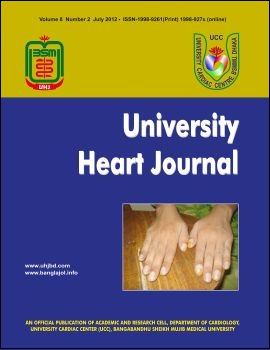A Comparison of the Clinical Impact of Enoxaparin-induced Bleeding Measured by two Different Classifications among Patient with Acute Coronary Syndrome
DOI:
https://doi.org/10.3329/uhj.v8i2.16080Keywords:
Acute coronary syndromes (ACS), Thrombolysis In Myocardial Infarction (TIMI), Global Use of Strategies to Open Occluded Coronary Arteries (GUSTO)Abstract
The risk of bleeding events that occur during the course of randomized clinical trials on various anti thrombotic medication is still an important issue. The existing guidelines for classifying bleeding events often presents variable results in the reported incidence of bleeding events within the same clinical trial. We analyzed data from 128 ACS patients treated with Enoxaparin in a randomized clinical trial to compare the association between the different degrees of in-hospital TIMI and GUSTO bleeding. In TIMI bleeding group, no TIMI bleeding, TIMI minimal bleed, TIMI minor bleed and TIMI major bleed were 92.9%, 4.7%, 1.6% and 0.8%, respectively. Patients with a TIMI minor bleed were younger (60.8±1.6 yrs; p 0.001) and those with TIMI major bleed had higher mean weight (61.08±1.25 kg; p 0.001), diabetes mellitus (100%; p 0.001) and hyperlipidemia (100%; p 0.001). In GUSTO bleeding group no bleeding, mild, moderate and severe bleeding was 89.84%, 4.68%, 3.91% and 1.56% respectively. Worsening GUSTO bleeding severity was associated with a gradient of increasing age (p 0.001), mean weight (p 0.002), with hypertension (p 0.001), diabetes mellitus ( p 0.001), and hyperlipidemia ( p 0.001).
DOI: http://dx.doi.org/10.3329/uhj.v8i2.16080
University Heart Journal Vol. 8, No. 2, July 2012
Downloads
275
178

